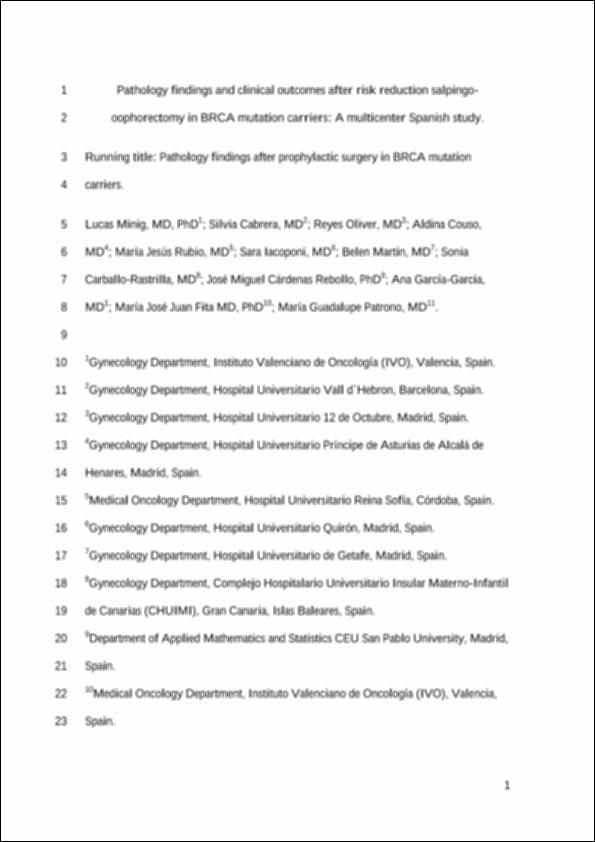Please use this identifier to cite or link to this item:
http://hdl.handle.net/10637/15220Pathology findings and clinical outcomes after risk reduction salpingo-oophorectomy in BRCA mutation carriers: a multicenter Spanish study

See/Open:
Pathology_Mining_et_al_Clin_TransOnco_2018.pdf
Restricted Access
172,87 kB
Adobe PDF
Request a copy
| Title: | Pathology findings and clinical outcomes after risk reduction salpingo-oophorectomy in BRCA mutation carriers: a multicenter Spanish study |
| Authors : | Minig Ramos, Lucas Cabrera, S. Oliver, R. Couso, A. Rubio, M.J. Iacoponi, S. Martin-Salamanca, M.B. Carballo-Rastrilla, S. Cárdenas Rebollo, José Miguel García-Garcia, A. Gil-Ibáñez, B. Juan-Fita, M.J. Patrono, M.G. |
| Keywords: | BRCA; Ovarian cancer; Primary peritoneal carcinoma; Risk reduction salpingo-oophorectomy; Serous tubal intraepithelial carcinoma |
| Publisher: | Springer |
| Citation: | Minig L, Cabrera S, Oliver R, Couso A, Rubio MJ, Iacoponi S, Martin-Salamanca MB, Carballo-Rastrilla S, Cádenas-Rebollo JM, García-Garcia A, Gil-Ibáñez B, Juan-Fita MJ, Patrono MG. Pathology findings and clinical outcomes after risk reduction salpingo-oophorectomy in BRCA mutation carriers: a multicenter Spanish study. Clin Transl Oncol. 2018 Oct;20(10):1337-1344. doi: 10.1007/s12094-018-1865-9. Epub 2018 Apr 5. PMID: 29623583. |
| Abstract: | Objective: To determine the incidence of serous tubal intraepithelial carcinoma (STIC) after risk reduction salpingo-oophorectomy(RRSO), and to describe oncological outcomes after RRSO. Materials and methods: BRCA pathogenic mutation carriers who had undergone an RRSO were evaluated in this retrospective multicenter observational study. Patients were only included when fallopian tubes were analyzed following the protocol for Sectioning and Extensively Examining the FIMbria (SEE-FIM). Surgeries were performed between June 2010 and April 2017 at eight Spanish hospitals. Results: A total of 359 patients met the inclusion criteria. STIC was diagnosed in 3 (0.8%) patients; one of them underwent surgical staging due to positive peritoneal washing, with absence of disease at the final pathology report. None of the three patients received adjuvant chemotherapy and were free of disease at last follow-up. Fallopian tube and ovarian carcinoma were diagnosed in 5 (1.4%) and 1 (0.3%), respectively. At a median (range) follow-up time of 29 (3-92) months, five patients had a newly diagnosed breast cancer. Other types of cancer, which were diagnosed during the follow-up time, included: serous primary peritoneal carcinoma (n = 1), serous endometrial carcinoma (n = 1), colon (n = 1), pancreas (n = 1), jaw (n = 1), and lymphoma (n = 1). Seven patients died due to different types of cancer: breast (n = 4), pancreas (n = 1), jaw (n = 1), and colon (n = 1). Conclusion: The incidence of STIC after RRSO in BRCA mutation carriers is low (0.8%) and it presents an excellent oncological outcome. Patients after RRSO, however, run the risk to develop other types of cancer during follow-up and should be properly advised before the prophylactic surgery. |
| Description: | Acceso al texto completo del artículo, disponible desde el sitio de la revista usando DOI: https://doi.org/10.1007/s12094-018-1865-9 Versión artículo en acceso abierto cumpliendo con la política de la revista |
| URI: | http://hdl.handle.net/10637/15220 |
| Rights : | http://creativecommons.org/licenses/by-nc-nd/4.0/deed.es |
| ISSN: | 1699-048X |
| Issue Date: | 5-Apr-2018 |
| Center : | Universidad San Pablo-CEU |
| Appears in Collections: | Enfermería |
Items in DSpace are protected by copyright, with all rights reserved, unless otherwise indicated.

